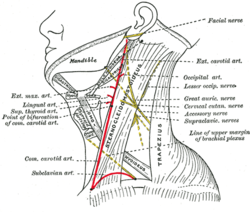|
Posterior triangle of the neck
The posterior triangle (or lateral cervical region) is a region of the neck. BoundariesThe posterior triangle has the following boundaries:[1] Apex: Union of the sternocleidomastoid and the trapezius muscles at the superior nuchal line of the occipital bone Anteriorly: Posterior border of the sternocleidomastoideus Posteriorly: Anterior border of the trapezius Inferiorly: Middle one third of the clavicle Roof: Investing layer of the deep cervical fascia Floor: (From superior to inferior) 1) M. semispinalis capitis 2) M. splenius capitis 3) M. levator scapulae 4) M. scalenus posterior 5) M. scalenus medius DivisionsThe posterior triangle is crossed, about 2.5 cm above the clavicle, by the inferior belly of the omohyoid muscle, which divides the space into two triangles:
ContentsA) Nerves and plexuses:
B) Vessels:
C) Lymph nodes:
D) Muscles:
Clinical significanceThe accessory nerve (CN XI) is particularly vulnerable to damage during lymph node biopsy. Damage results in an inability to shrug the shoulders or raise the arm above the head, particularly due to compromised trapezius muscle innervation. The external jugular vein's superficial location within the posterior triangle also makes it vulnerable to injury. See alsoReferences
External links
|
||||||||||||||||||||||

